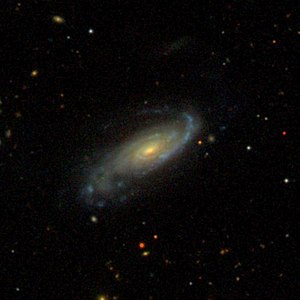NGC 5183
aus Wikipedia, der freien Enzyklopädie
| Galaxie NGC 5183 | |
|---|---|

| |
| SDSS-Aufnahme | |
| AladinLite | |
| Sternbild | Jungfrau |
| Position Äquinoktium: J2000.0, Epoche: J2000.0 | |
| Rektaszension | 13h 30m 06,1s[1] |
| Deklination | −01° 43′ 14″[1] |
| Erscheinungsbild | |
| Morphologischer Typ | Sb / LINER[1][2] |
| Helligkeit (visuell) | 12,7 mag[2] |
| Helligkeit (B-Band) | 13,5 mag[2] |
| Winkelausdehnung | 1,9′ × 0,8′[2] |
| Positionswinkel | 122°[2] |
| Flächenhelligkeit | 13,0 mag/arcmin²[2] |
| Physikalische Daten | |
| Rotverschiebung | 0.014310±0.000033[1] |
| Radialgeschwindigkeit | 4290±10 km/s[1] |
| Hubbledistanz H0 = 73 km/(s • Mpc) |
(189 ± 13) · 106 Lj (57,9 ± 4,1) Mpc [1] |
| Geschichte | |
| Entdeckung | Wilhelm Herschel |
| Entdeckungsdatum | 11. April 1787 |
| Katalogbezeichnungen | |
| NGC 5183 • UGC 8485 • PGC 47432 • CGCG 016-079 • MCG +00-34-039 • IRAS 13275-0127 • 2MASX J13300614-0143144 • GC 3565 • H II 679 • h 1617 • | |
NGC 5183 ist eine 12,7 mag helle Spiralgalaxie mit aktivem Galaxienkern vom Hubble-Typ „Sb“ im Sternbild Jungfrau nördlich der Ekliptik. Sie ist schätzungsweise 189 Millionen Lichtjahre von der Milchstraße entfernt und hat einen Durchmesser von etwa 105.000 Lj.
Im selben Himmelsareal befinden sich u. a. die Galaxien NGC 5192, NGC 5196, NGC 5197, NGC 5202.
Das Objekt wurde am 11. April 1787 von Wilhelm Herschel[3] mit einem 18,7-Zoll-Spiegelteleskop entdeckt, der sie dabei mit „Two. The preceding F, pS, iF. The following pB, pL, iF, bM“[4] beschrieb. Die zweite genannte Galaxie ist NGC 5184.
Weblinks
[Bearbeiten | Quelltext bearbeiten]- NGC 5183. SIMBAD, abgerufen am 6. Juli 2015 (englisch).
- NGC 5183. DSO Browser, abgerufen am 6. Juli 2015 (englisch).
Einzelnachweise
[Bearbeiten | Quelltext bearbeiten]Text is available under the CC BY-SA 4.0 license; additional terms may apply.
Images, videos and audio are available under their respective licenses.
